How we made HAJJ 360
A 360-degree experiment in Mecca
I visited Mecca three weeks before the Hajj period film the major landmarks of this annual pilgrimage before the arrival of more than two million worshippers. I wanted to show our viewers how these places look like when they were relatively empty.
For this trip, I equipped myself with one camera - Ricoh ThetaM15 - that takes 360-degree images and footage. It basically shoots everything around me, including myself.
I bought the camera from an online store in Germany for 300 euros. It arrived just a day before my travel, so I had little time to learn how to use the device.
I started shooting the moment I arrived in Mecca, specifically in Masjid al-Haram or the Grand Mosque, the largest mosque in the world.
I held the camera in front of me with my arm stretched (as if I was taking a selfie) and began walking in the mosque to capture everything I saw there, including the Kaaba, Islam’s holiest structure.
The camera has two lenses to take two spherical images that - once stitched together - will provide a 360-degree image.
There is one big button to press to both take videos or snap photos. I found the camera very easy to use.
From the mosque, I went on to film in Mina, Muzdalifa and Arafat - all areas in Mecca that are central to the pilgrimage.
In all these places, nobody stopped me to ask what I was doing or why I was filming. The Ricoh ThetaM15 camera is small, light and discreet/discreet . This is the main feature that distinguishes this 360-degree camera from the others on the market.
I had to stop an hour into the shooting when the camera’s light began flashing. It was an indication that the internal memory (4GB) was running out. I transferred the footage onto my laptop and started another session. It’s also worth noting that the camera can only shoot clips no longer than five minutes-long each.
At night I checked what I had filmed throughout the day.
The files you initially get from the camera are in .MOV format and display the footage as two spheres next to each other.
First step
Opening the raw video

One must download from the Ricoh Theta website a software that will stitch the images to present them in a 360-degree view.
The final result after the stitching is incredible. I came to realise how much details I had missed while in Mecca: the ornaments in on the mosque’s ceiling, the floors, the public interactions near you and behind you… Of course, in real life you cannot see what’s behind you as you walk.
The footage makes you feel as though you were there.
Second step
Processing the spherical video

On the debit side, the footage did not have a professional finish for a number of reasons.
Firstly, For one, the footage is fuzzy and pixelated (albeit good enough for enjoyable viewing on smartphone and PC). For another, I struggled to know to hold the camera without my finger being visible prominently in all the footage. Next time I will try to mount it on a monopod to see if this makes a lot of difference.
I also realised that the best footage was the one I took when I was holding it straight and parallel to me, as opposed to sideways.
I gave the footage to my colleague Mohammad Haddad, the interactive team leader, who edited the footage using Adobe Premier.
Third step
Video and audio editing in Adobe Premier
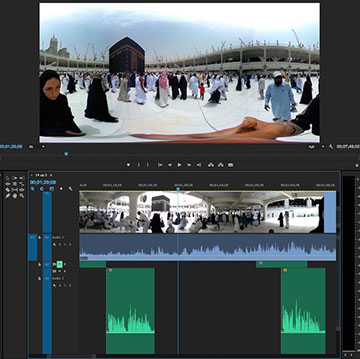
I voiced the footage (in both English and Arabic) to explain to the viewers my tour and give some context about the landmarks and about the Hajj journey in general.
After a few takes we were able to cut the video down from 25 minutes in the original version to less than 8 minutes. We knew we had to keep the video concise - especially considering that the best experience with 360-degree video is on mobile.
The next step was to render the video and inject Youtube's 360 degree code. - https://support.google.com/youtube/answer/6178631?hl=en
Fourth step
Injecting the 360 degree code for Youtube

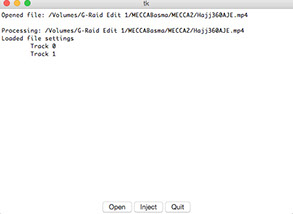
Fifth step
Packaging and reversioning
We used Adobe Muse to design and develop the mobile and desktop pages. We decided to package these Youtube videos onto a page because very few people that we showed the demos to actually knew how to interact with this new 360-degree interface.
As far as we know, Youtube is the only video platform right now that natively supports 360-degree videos. Facebook is apparently working on a dedicated app so once that comes out, we'll be able to provide this experience there.
This for us was an experiment. We wanted to try to tell the story of Hajj in an innovative way and to bring viewers closer to the pilgrims’ experience, especially that Mecca is a place inaccessible to a lot of people - non-Muslims, for example. At the same time, we had no option of walking around the mosque carrying bulky equipment, such as the Gopro 360 rig, which produces high-quality footage.
We hope that we can relay the lessons we learned from this trial to other journalists on the ground, because we believe that the 360-degree footage can give the viewers an immersive experience and that this could be the next photography and filming revolution.
Unexpected issues
Dealing with text, deformed logos, and orientation
Dealing with on screen text turned out to be tricky. Essentially, you need to imagine what everything would look like once stitched up as a sphere. Placing text anywhere near the corners of the page will horribly distort it.
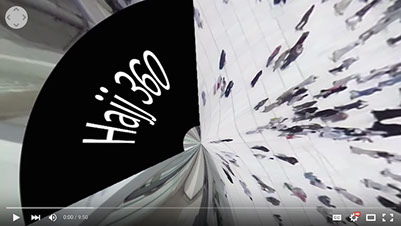
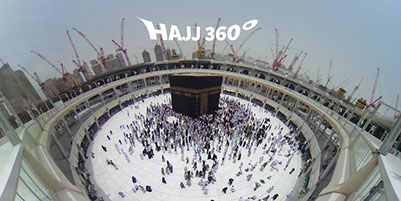
To fix this, we tried two solutions.
One was to deliberately distort the text using Photoshop's inverted sphererise tool. This seemed to work but wasn’t necessarily going to be consistent across different screens.
The better and simpler solution was to centre all the text and keep it smaller than ¼ of the frame of the video. Anything larger and the reader wouldn’t be able to read the text in one viewing.

This distortion also required us to rethink where we placed our logo. Traditionally, this is placed in the bottom left of the screen. No solution that we tried was able to give us an undistorted logo.
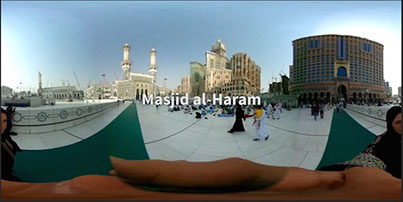
This for us was an experiment. We wanted to try to tell the story of Hajj in an innovative way and to bring viewers closer to the pilgrims’ experience, especially that Mecca is a place inaccessible to a lot of people - non-Muslims, for example. At the same time, we had no option of walking around the mosque carrying bulky equipment, such as the Gopro 360 rig, which produces high-quality footage.
We hope that we can relay the lessons we learned from this trial to other journalists on the ground, because we believe that the 360-degree footage can give the viewers an immersive experience and that this could be the next photography and filming revolution.
The best option was not to include it. For future projects, the solution may involve having your correspondent wear our company's branding.
Autori: Basma Atassi i Mohammed Haddad

© AL JAZEERA MEDIA NETWORK, 2015